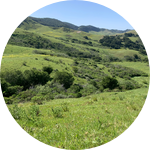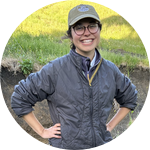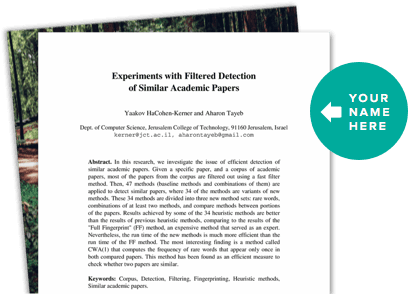About This Project
Soil bacteria remove ~30 Mt of methane/year from the atmosphere, but this rate varies strongly with land use. We discovered that sage scrub ecosystems are a local hotspot for natural methane uptake, exceeding dataset averages by up to 1,240%. Why are these landscapes so effective at atmospheric methane removal? We will identify the causes, using our findings to develop soil amendments and management guidelines for better methane uptake in other landscapes.
Ask the Scientists
Join The DiscussionWhat is the context of this research?
As scientists are working to develop methane drawdown technologies, bacteria in soils are already consuming ~30% as much methane as is produced by the fossil fuel industry each year. Across hundreds of studies, land use has emerged as the strongest correlating factor of soil methane uptake rates–this highlights the potential to influence the soil methane sink through land use decisions. In our multi-year survey of California soils, we recorded the highest methane consumption rates in a coastal sage scrub landscape. We found that average rates in sage scrub locations exceeded rates in grasslands by 239%, even when sage and grassland sites were in the same location and climate. Our discovery points to a unique property of sage soils that enhances natural methane uptake. We propose to uncover the chemical or biological factor that enhances methane uptake in sage soils, and test how to apply this factor in other managed soils.
What is the significance of this project?
Methane is a potent greenhouse gas, with ~85 times as much heat-trapping potential as CO2 on a 20-year timescale. Rapidly improving global methane drawdown is a crucial goal for averting near-term climate warming. Based on our preliminary measurements, a simple soil amendment based on sage scrub soil could enhance methane uptake rates by >200%, contributing significantly to methane removal goals. 52% of U.S. land area is already managed for agricultural use, and a 200% enhancement of methane uptake across this land area alone would amount to increased methane drawdown of 2.24 Mt/yr, a ~7% improvement in the global soil methane sink.
What are the goals of the project?
We will construct experimental plots at two California field sites with adjacent sage scrub and grassland landscapes. Experimental plots will be used to test the effects of sage removal, sage planting, sage leaf litter application, and sage root application at 6-month and 12-month timepoints, alongside unaltered sage scrub and grassland control plots. We will track methane uptake for each plot, and use sequencing, metabolomics, and geochemical analyses to identify the unique factors that drive rapid methane uptake in sage scrub soils. These may include specific plant metabolites, bacterial species, or root structures.
Based on our results from this proposed research, we will develop and launch a second phase of the project to directly test the relevant soil components as soil amendments to additional experimental plots and quantify the enhancement in methane drawdown.
Budget
Field sample collection. We have secured access to two field sites where we can install our field experiments. Our budget will cover the cost the materials required to construct 16 experimental plots, and transportation for initial setup and two subsequent sampling visits.
Analyses. Metabolomics (via LC-HRMS) is an essential analytical tool to determine the unique properties of sage soils that promote enhanced methane uptake. Our budget covers 32 samples at $135/sample. Sequencing analysis, at $22/sample, allows us to investigate which bacteria are participating in methane uptake. Further analyses–including the abundance of essential nutrients and metals, soil structural characterization, and/or stable isotope probing–will be performed as needed through other internal or external funds.
Consumables. Our budget covers the purchase of the necessary DNA extraction kits, reagents for extracting metabolites, and sterile materials for collecting and handling samples.
Endorsed by
 Project Timeline
Project Timeline
To test how and why our sage-inspired soil treatments affect methane uptake throughout the year, we will set up plots before the start of the growing season. We will collect samples at two different timepoints (Sampling campaigns 1 and 2) to assess the effectiveness of the treatments over time and across seasonal changes. Sample analysis will quickly follow after collection, and we will report results as available. We may add further timepoints to fully observe the effect of treatments.
Jan 23, 2025
Project Launched
Feb 15, 2025
Construct experimental plots
Apr 01, 2025
Develop and optimize extraction methods
Aug 01, 2025
Sampling campaign 1: Late growing season field collection
Aug 15, 2025
Sampling campaign 1: Sample processing and analysis
Meet the Team
Affiliates
Hannah Dion-Kirschner
Hannah is a Ph.D. candidate and Resnick Sustainability Institute Fellow at Caltech. She is a biogeochemist studying the role of soils and plants in greenhouse gas removal. With training in both biology and earth science, she brings a unique cross-disciplinary perspective to these critical questions about the carbon cycle.
As a field researcher and volunteer outdoor educator, Hannah has collaborated closely with land managers, public schools, government researchers, and nonprofits. Her most recently published research can be found in the Environmental Research Letters Special Issue: Focus on Methane Drawdown.
Woodward Fischer
Woodward Fischer holds a B.A. and honorary doctorate from Colorado College and a Ph.D. from Harvard. Dr. Fischer is often called by his nickname, Woody. His research generally falls in the discipline of geobiology — combining techniques from Earth and environmental science, analytical chemistry, and biology — to understand and explore the relationships between life and Earth surface environments through diverse and fundamental intervals of global change.
Lab Notes
Nothing posted yet.
Additional Information
While our project will focus specifically on methane drawdown via bio-inspired soil amendments, coastal sage scrub is a vital native California ecosystem. Its beautiful, drought-tolerant plants are incredibly fragrant and provide habitat for many native and threatened animals. Previous work estimated that of the ~1 million hectares of coastal sage scrub original to California, as little as 10% remains. Our preliminary data suggests that restoring invasive grasslands to coastal sage scrub could increase methane uptake by 4.2 kg per acre each year, while protecting native species and habitat.
Project Backers
- 2Backers
- 1%Funded
- $11Total Donations
- $5.50Average Donation



